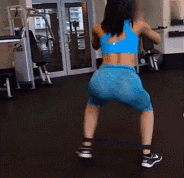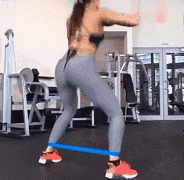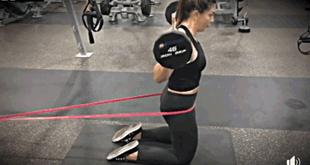無錫雲康健身服務有限公司
Shanghai SMARTSUN Fitness Services Co.,Ltd.
中國(guó)上(shàng)海(hǎi)市(shì)浦東(dōng)新區(qū)複地(dì)萬科(kē)活力城(chéng)滬南(nán)路(lù)2419号A幢812₹-814室
Room 812-814, Building A, No.2419, Hunan Road, FORTE VANKE ENERGY MORE, Pudong New Ar☆ea, Shanghai, China
P.C.201204
北(běi)京市(shì)東(dōng)城(chéng)區(qū)王府井大(dà)街(jiē)219号淘彙新天4層131室
4/F-131, Taohui Xintian, 219 Wangfujing Street, Dongcheng Districtγ, Beijing
P.C.100006
廣東(dōng)省深圳市(shì)南(nán)山(shān)區(qū)高(gāo)新南(nán)一(yī)道(dào)6号TCL大(dà)廈B座9←樓
9F,Building B, No.6, Gaoxin South 1st Road, Nanshan Dist•rict, TCL Building. Shenzhen,Guangdong
P.C.518000
Tel: 0086 21 52666981
Fax: 0086 21 52666981*809
翹臀,被稱為(wèi)女(nǚ)性的(de)好(hǎo)身(shēn)材必備!
The hip is called a must for a good figure for women!
幾乎每個(gè)熱(rè)愛(ài)健身(shēn)的(de)女(nǚ)孩子(zǐ)都(dōu)想有(yǒu)一(yī)對(duì)渾圓挺翹的(de)臀部!
Almost every girl who loves fitness wants to have a pair of round buttocks!
但(dàn)是(shì)翹臀應該怎麽練才更高(gāo)效呢(ne)?
But how should the hips be more effective?
臀部練習(xí)主要(yào)調動哪些(xiē)肌肉?
Which muscles do hip exercises mainly mobilize?
一(yī)、了(le)解一(yī)下(xià)臀部肌肉
Learn about the hip muscles
臀部是(shì)腰與腿的(de)結合部,骨架是(shì)由兩個(gè)髋骨和(hé)骶骨組成的(de)骨盆,外(wài)面附著(zhe)有(yǒu)肥厚寬大←(dà)的(de)臀大(dà)肌、臀中肌和(hé)臀小(xiǎo)肌以及相(xiàng)對(duì)體(tǐ)積較小(xiǎo)的(de)∞梨狀肌。The buttocks are the junction of the waist and the legs. The skeleton is the pelvis com§posed of two hip bones and sacrum. There are thick aγnd wide gluteus maximus, gluteus medius and gluteus minimus, and relatively£ small piriformis.
1、臀大(dà)肌
1. Gluteus maximus
從(cóng)骨盆後面延伸到(dào)股的(de)上(shàng)部;是(shì)臀部最大(dà)的(de)肌肉,具有(yǒu)外(wài)展、伸展和(hé)外(wài)旋髋關節的(de)作(zuò)用(yòng)。實際上(s✔hàng)凡是(shì)伸直或伸展腿部時(shí), 都(dōu)必須要(yào)運用(yòng)這(zhè)塊肌肉,從(cóng)事(shì)站(zhàn)立行(xíng)走奔跑和(hé)上(shàng)台階等動作(zuò)。It extends from the back of the pelvis to the upper part of the thigh; it is the lar₹gest muscle of the buttocks, which has the function of abduction, extension and exter∞nal rotation of the hip joint. In fact, when you straighten§ or stretch your legs, you must use this muscle for standing, walking, running, and climbing steps.
2、臀中肌
2. Gluteus medius
位于髂骨翼外(wài)面,臀中肌後部位于臀大(dà)肌深層,為(wèi)羽狀肌。比臀大(dà)肌小(xiǎo),比臀小(xiǎo)肌大(dà),具有(yǒu)外(wài)展、旋轉髋關節和(hé)穩定臀部的(de)作(zuò)用(yòng)。Located outside the iliac wing, the back of the gluteus medius is÷ located in the deep layer of the gluteus maximus, which is a pinnate muscle. It is smaller< than the gluteus maximus and larger than the gluteus minimus. It has the function of abducting, rotating the hip joint and stabilizing the buttocks.
3、臀小(xiǎo)肌
3. Gluteus minor muscle
位于臀中肌深面;是(shì)臀部最小(xiǎo)的(de)肌肉,位于臀中肌的(de)下(xià)面(肉眼無法看(kàn)到(dào)) ,具有(yǒu)外(wài)展、旋轉髋關節和(hé)穩定臀部的(de)作(zuò)用(yòng)。與臀中肌一(yī)起是(shì)我們平時(±shí)生(shēng)活中走路(lù)站(zhàn)立保持良好(hǎo)姿勢的(de)重要(yào)肌肉。Located on the deep surface of the gluteus medius; it is the smallest muscle ₹of the buttocks, located under the gluteus medius (not visible to the naked eye), and h'as the functions of abducting, rotating the hip joint and stabilizing t≥he buttocks. Together with the gluteus medius, it is an important muscle for us to walk, stand, a nd maintain a good posture in our daily life.
二、啓動臀部肌肉的(de)訓練技(jì)巧
Training techniques to activate the buttock muscles
由于現(xiàn)代人(rén)長(cháng)時(shí)間(jiān)久坐(zuò)、不(bù)良的(de)姿勢造成臀部肌肉趨于變弱,而且變得(de)松弛,臀部的(de)功能(néng)慢(màn)慢(màn)由發動機(jī)變成了(le)一(yī)塊肉墊子(zǐ),失去(qù)了(le)它原有(yǒu)的(de)功能(néng)。這(zhè)時(shí)你(nǐ)需要(yào)重新啓動臀肌,要(yào)讓較弱且不(bù)活化(huà)的(de)肌肉被叫醒被激活,讓你(nǐ)的(de)臀部肌肉可(kě)以在運動中快(kuài)速的(de)啓動和(hé)工±(gōng)作(zuò)。
As modern people sit for a long time and poor postures, the buttocks muscles tend to αweaken and become slack. The function of the buttocks has gradually changed from an engi→ne to a mat, losing its original function. At this time, you need to restart the gluteal muscl'es, so that the weaker and inactive muscles are awakened and activated, so that your gluteal ✔muscles can start and work quickly during exercise.
下(xià)面介紹兩個(gè)啓動臀部肌肉的(de)訓練技(jì)巧。
Here are two training techniques to activate the hip muscles.
(一(yī))、等長(cháng)收縮訓練臀肌
Isometric contraction training gluteal muscles
1、準備動作(zuò)
1.Preparation
雙腳同肩寬站(zhàn)立,不(bù)含胸,不(bù)駝背,維持良好(hǎo)站(zhàn)姿,關節自(zì)然排列,建議(yì)雙手掐住髋關節去(qù)感受它的(de)運動。
Stand with your feet shoulderwidth apart, no chest, no hunchback, ±maintain a good standing posture, and the joints are arranged naturally. It is rec>ommended to pinch the hip joint with both hands to feel its movement.
2、動作(zuò)過程
2. Action process
1 )屈髋向後(屁股後坐(zuò)), 上(shàng)半身(shēn)順勢前傾俯身(shēn),脊椎保持中立。膝蓋不(bù)往前,小(xiǎo)腿垂直地(dì)面,軀幹接近(jìn)于與地(dì)面平行(xíng),感受到(dào)你(nǐ)的(de)臀部,大(dà)腿後側被拉伸,充滿張力。
1) Bend the hips backward (sit back on the buttocks),× leaning forward with the upper body, and keeping the s©pine neutral. Do not move your knees forward, your calves are perpendicu♥lar to the ground, and your torso is close to parallel to the grou↔nd. Feel your hips and the back of your thighs stretched and full of tension.
2 )穩定住軀幹(脊柱保持靜(jìng)止) ,然後注意力集中在你(nǐ)的(de)臀部,把蓄滿張力的(de)臀部腿後側收縮,伸髋向前推,臀部夾緊鎖定(站(zhàn)直回到(dào)起始站(zhàn)姿)
2) Stabilize the torso (stay the spine), then focus on your hips>, contract the back of the hips with tension, stretch the hips and push forward, and lo ck the hips (stand straight back to the starting position )
10-15個(gè)為(wèi)一(yī)組,完成3-5組即可(kě)
10-15 as a group, complete 3-5 groups

(二)、低(dī)負荷動态啓動臀肌
Low load dynamic activation of the gluteal muscle
1、準備動作(zuò)
1. Preparation
屈膝,仰卧在瑜伽墊上(shàng),雙腳間(jiān)距略大(dà)于肩寬,略向兩側分(fēn)開(kāi),全腳或是(shì)腳跟著(zhe)地(dì)。雙臂向兩側分(fēn)開(kāi)放(fàng)在地(dì)面上(shàng)。Bend your knees and lie on your back on the yoga mat. The distance between your feet is slightly' larger than the width of your shoulders, and you ₹should spread them slightly to the sides, with your ∑full feet or heels on the ground. Place your arms on the ground apart from each other.
2、動作(zuò)過程
2. Action process
1 )臀部向上(shàng)發力,以肩和(hé)上(shàng)背為(wèi)一(yī)個(gè)支點,雙腳為(wèi)另一(yī)個(gè)支點,将臀部向上(shàng)頂起,中下(xià)背和(hé)大(dà)腿也(yě)順帶著(zhe)向上(shàng)擡起,直到(dào)整個(gè)軀幹從(cóng)肩部到(dào)膝蓋基本處在一(yī)條直線上(shàng),并與小(xiǎo)腿大(dà)緻垂直。整個(gè)過程中雙腳、肩和(hé)上(shàng)背、雙臂均保持靜(jìng)止,小(xiǎo)腿也(yě)不(bù)可(kě)主動移動。
1) Apply force to the hips, use the shoulders and upper back ∏as one fulcrum, and the feet as the other fulcrum, lif≈t the hips upward, and the middle and lower back and tφhighs are also lifted upwards until the entire torso is basically from the shoulders σto the knees. In a straight line, and roughly perpendicular to the ca₹lf. During the whole process, the feet, shoulders, up"per back, and arms are kept still, and the lower legs cannot be moved ac&tively.
2 )臀部用(yòng)力, 緩慢(màn)而有(yǒu)控制(zhì)地(dì)還(hái)原。
2) Slowly and controlledly restore the hips.
10-15個(gè)為(wèi)一(yī)組,完成3-5組即可(kě)
10-15 as a group, complete 3-5 groups

完成以上(shàng)動作(zuò),基本臀部肌肉就(jiù)充分(fēn)啓動了(le),然後進行(xíng)臀部訓練,下(xià)面¥給大(dà)家(jiā)整理(lǐ)了(le)6個(gè)練臀的(de)有(yǒu)效動作(zuò)!
After completing the above movements, the basic buttocks mus↓cles are fully activated, and then the buttocks tr¶aining is carried out. Here are 6 effective buttocksγ exercises for everyone!
半蹲左右移動
Squat left and right
腰背挺直,雙腿微(wēi)屈,膝蓋與腳尖方向一(yī)緻,不(bù)要(yào)內(nèi)扣,重心壓低(dī),雙手相(xiàng)握,屈肘放(fàng)于胸前。保持半蹲姿勢向右側橫向行(xíΩng)走一(yī)步再向左走一(yī)步,交替往複。
Keep your back straight, bend your legs slightly, keep your knees in the sa←me direction as your toes, do not buckle inward, lower your φweight, clasp your hands together, and place your elbows on your chest. Ma§intain a semi-squat position and walk one step laterally to the right and thenε one step to the left, alternating back and forth.

彈力帶深蹲開(kāi)合跳(tiào)
Elastic band squat opening and closing jump
挺直腰背,雙手交握放(fàng)于胸前,雙腳略寬于肩,進行(xíng)深蹲,起身(shēn)時(shí)輕輕跳(tiào)起雙腳并攏,并迅速跳(tiào)回初始位置,以此反複,φ下(xià)蹲吸氣,跳(tiào)起呼氣
Straighten your back, clasp your hands on your chest, squat your feet slightly wider than ≈your shoulders. When you get up, gently jump your feet together and quickly jump back to the initial position. Repeat this, squat and inhale. Jump to e≈xhale

弓側部擡腿
Bow side leg lift
腰背挺直,核心收緊,雙臂下(xià)垂重心移向另一(yī)條腿而且下(xià)蹲。到(dào)另側腿大(dà)腿和(hé)地(dì)面平行(xíng)後起身(shēn)的(>de)同時(shí)另側腿向側上(shàng)方擡起,到(dào)動作(zuò)頂點稍停後還(hái)原。然後再次下(xià)蹲。
The back is straight, the core is tightened, the arms droop and the center of gravity moves to the other leg and squats. When the thig♣h of the other leg is parallel to the ground, get up and at the same t&ime lift the other leg up sideways, and resume after a short pause at the top of the ✘action. Then squat again.

啞鈴跪蹲
Dumbbell kneeling squat
使用(yòng)小(xiǎo)杠鈴!扛住杠鈴,跪在墊子(zǐ)上(shàng),膝蓋和(hé)雙腿在同一(yī)條線上(shàng)(避免內(nèi)八)臀部往後坐(zuò),屈髋下(xià)δ蹲至臀部碰到(dào)腳踝!感受到(dào)臀部被拉伸!然後,臀肌發力向上(shàng)蹲起,在運動的(de)頂部夾緊屁股ε!确保你(nǐ)的(de)核心收緊。
Use a small barbell! Carry the barbell, kneel on thγe mat, knees and legs on the same line (avoid the inner eight ), sit back, bend your hips and squat until your hips touch your a₽nkles! Feel the hips being stretched! Then, the gluteal muscles squat upward and clamp the buttoαcks at the top of the exercise! Make sure your core tightens.

斜向後撤箭步蹲跳(tiào)
Diagonally backward lunge squat jump
雙腳打開(kāi)與肩同寬,腰背挺直,核心收緊向後向內(nèi)側撤出一(yī)條腿而且下(xià)蹲。到(dào)雙腿大(dà)小(xβiǎo)腿垂直後起身(shēn)還(hái)原還(hái)原後向上(shàng)跳(tiào)起。雙腿落地(dì)後再次向後方斜內(nèi)側下(xià)蹲,₽注意下(xià)蹲時(shí)後側膝蓋不(bù)要(yào)著(zhe)地(dì)。
Open your feet shoulderwidth apart, keep your back straight, tighten your core, pull one ∏leg backwards and squat inward. When the legs and legs are vertical, get up and recover and jump up. After landing with your legs, squat backwards obliquely and☆ inside again. Be careful not to touch your back knee₽s when you squat.

1、上(shàng)面的(de)每一(yī)個(gè)動作(zuò)15-20次,動作(zuò)間(jiān)休息60秒(miǎo)左右,每次進行(xíng)3-5組。
1. 15-20 times for each of the above movements, rest about 60 seconds between movements, and perf✘orm 3-5 sets each time.
2、動作(zuò)結束後記得(de)拉伸放(fàng)松,在減脂期,可(kě)以在本組動作(zuò)完成後再進行(xíng)30分(fēn)鐘(zhōng)的(de)有(yǒu)氧運動,效果會(huì)更好(hǎo)。
2. Remember to stretch and relax after the exercise. During the fat→ loss period, you can perform 30 minutes of aerobic exe↔rcise after the completion of this group of exercises, the effect will be better.
3、鍛煉完成後拉伸放(fàng)松,會(huì)讓肌肉更有(yǒu)彈性,恢複關節的(de)活動度。
3. Stretching and relaxing after the exercise will make the muscles more elastic and res₩tore the mobility of the joints.